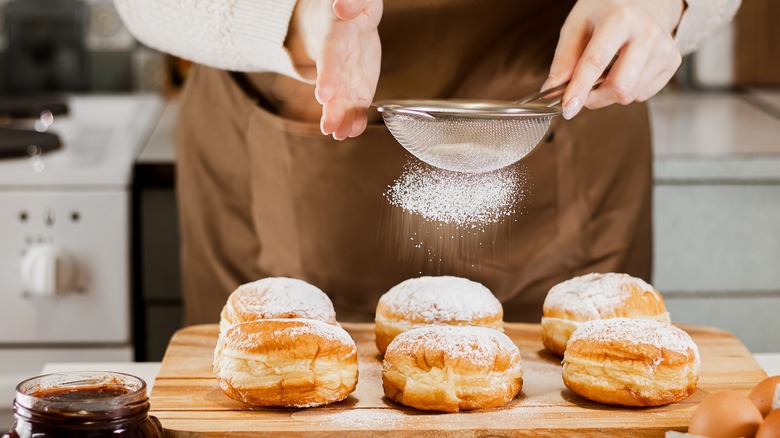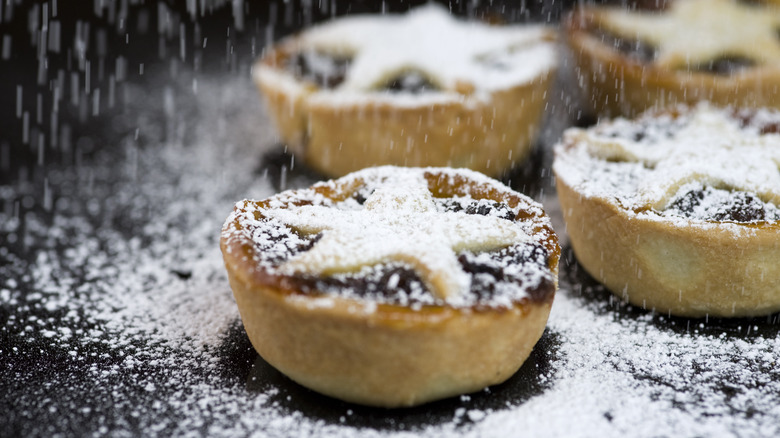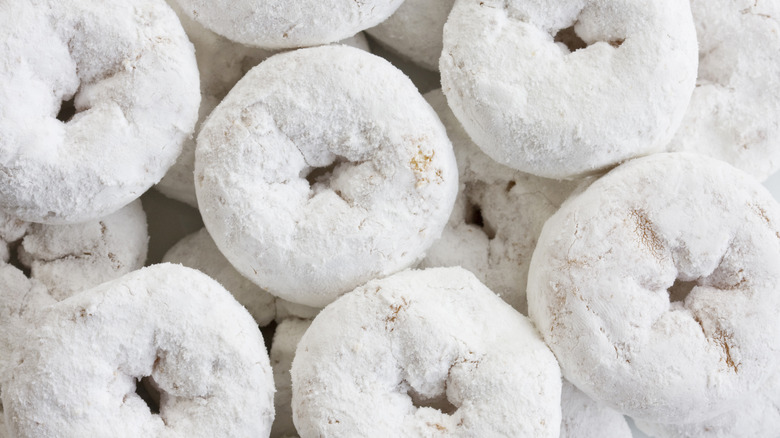The Best Substitute For Powdered Sugar Is Already In Your Pantry
You may know it as confectioner's sugar, often used to sweeten cakes, cookies, and brownies, or as icing sugar that's whipped into thick buttercream and frosting — but they are both the same thing: powdered sugar. Though it may not seem like an essential ingredient to have in your baking stash at all times, powdered sugar is a sweetener that's worth keeping in your pantry. After all, what else would you use to dust your bakes or make sweet icing and glazes? But, if you don't have any, there's an easy substitute to make up for powdered sugar at home, and it's hiding in plain sight.
Powdered sugar is really nothing but regular granulated white sugar that's been ground into a fine powder — gentle enough to easily dissolve in liquids. Needless to say, it's not exactly rocket science to make your own powdered sugar at home. All you'd have to do is toss a few spoonfuls of granulated white sugar into a food processor or a blender and give it a quick blitz — that's all there really is to it!
Store-bought varieties often have cornstarch in them as well since the starch works as an anti-caking agent to prevent the powdered sugar from clumping. So, when whipping up a batch of powdered sugar at home, be sure to throw in the cornstarch too — or any other variety like tapioca or potato starch — ideally using a tablespoon for every cup of sugar that you grind.
How to turn granulated white sugar into powdered sugar
Making your own powdered sugar out of granulated white sugar is as easy as pie, but there are a few things to keep in mind when doing so. For one, granules of white sugar can be blitzed in a blender or a food processor for the easiest option, but you can also use a spice grinder, a coffee grinder, or even a mortar and pestle in a pinch.
That being said, it may not always be the wisest thing to do; coffee and spice grinders will only blitz small batches of granules, which may be handy when you need a quick tablespoon or two of powdered sugar, but will be arduous when a recipe calls for more. In those cases, the best way to make big batches of fine and fluffy powdered sugar is to use a high-speed blender and then sift it using a mesh sieve to get rid of any lingering clumps.
It's also important to know just how much granulated sugar you should use. Ideally, you'll get double the amount of powdered sugar for every serving of granulated sugar you use — about two cups of powdered sugar for every cup of granulated sugar, for example. Once you get the hang of the ratio and the method to grind it, you don't have to stop at just granulated white sugar. You could also turn unrefined cane sugar, maple sugar, brown sugar, coconut sugar, or any other variety of sugar into your own batch of powdered sugar at home.
Other powdered sugar substitutes to use in a pinch
If for any reason making powdered sugar at home is not an option, there are several other ingredients that you can use as nifty substitutes. Hot cocoa mix, which usually has some element of sugar already in it, is an excellent alternative, especially in chocolate-based desserts. Simply use a little more hot cocoa mix than the powdered sugar that your recipe asks for, and account for the extra flavoring of chocolate that the mix will add.
When mixed with cornstarch and a sweetener like Splenda, dry milk powder is another fantastic substitute considering its pulverized texture that is very similar to that of powdered sugar. Dry milk powder also works when you want the texture of powdered sugar but wish to cut down on the sucrose — all you'd have to do is dilute some of the powdered sugar with dry milk powder. The only thing to be careful about when using dry milk powder is knowing that it soaks up more liquid than powdered sugar. This is why you may likely have to add more liquid to your recipe when swapping it in.
Other excellent substitutes for powdered sugar, especially when using it for a finishing dusting on desserts, are shredded coconut, matcha powder, or even ground-up freeze-dried fruits. Not only will the fruits have sweetness from the natural sugars present in them, but they'll also add their own flavors to the mix and a pop of color to go with it!



